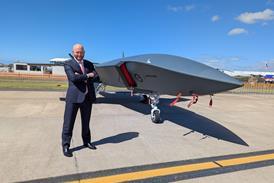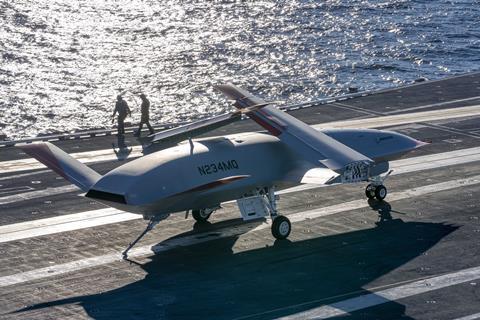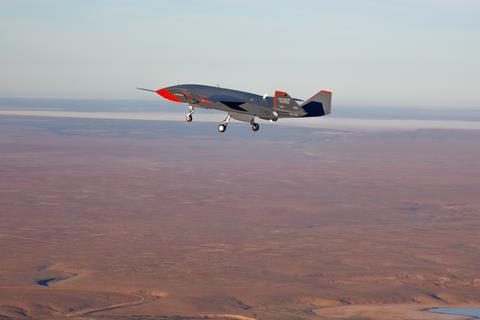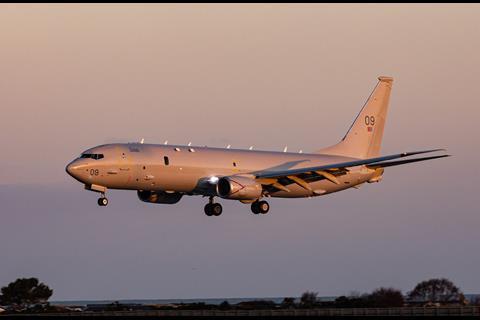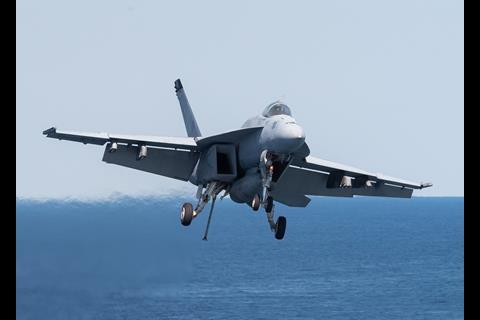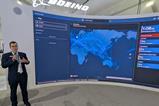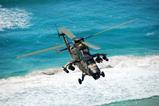Ted Colbert, the new head of Boeing Defense, Space & Security, stands poised to lead his organisation in a decade where the emphasis is decidedly shifting from specific platforms to networked assets and the new frontier of autonomy.
Less than three months after being named head of Boeing’s defence business, Colbert cuts an upbeat, enthusiastic figure in an interview with FlightGlobal in Singapore. He was in town for the annual Shangri-La Dialogue defence gathering, where military leaders discuss geopolitics and Asia-Pacific security challenges.
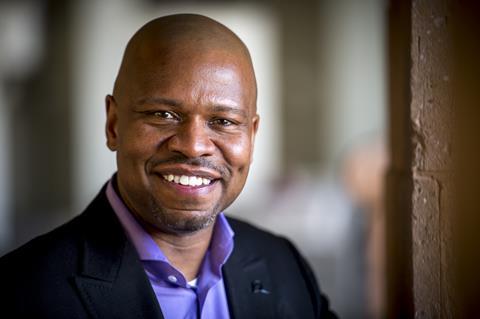
Colbert spent his first weeks in the role listening and gathering feedback. He cites Boeing’s ‘Seek, Speak & Listen’ initiative as a guiding principle.
“I’ve been spending most of my time at events like this… spending time with our customers, understanding what their priorities are, getting a better understanding of the challenges that we have, and trying to ground myself in the realities of the many current situations going on around the world, and trying to match that with near-term and future priorities for the defence business.”
Colbert has also spent time with colleagues internally coming to grips with things, especially as the world emerges from the coronavirus pandemic. “I’ve done several roundtables and touched hundreds – if not thousands – of our teammates, just listening and understanding what’s going on.”
Even before this Colbert already had a clear-eyed view of Boeing’s opportunities and challenges. Prior to becoming president and chief executive of the defence business, he headed Boeing Global Services, which deals with both commercial and government customers globally.
Colbert has also served as the company’s chief information officer. An engineer by training, his resume has a distinct Information Technology (IT) focus, with senior IT roles at Citigroup and the Ford Motor Company. Colbert feels that working in IT gave him a broad view of things, both at the strategic and platform levels.
With eight divisions, Defense, Space & Security is one of Boeing’s three pillars – the others being Global Services and Commercial Airplanes. The unit produces a range of systems, from fixed-wing fighters such as the F-15EX and F/A-18E/F Super Hornet, to helicopters such as the AH-64 Apache and CH-47 Chinook. It is also responsible for Boeing’s space business, including the Starliner spacecraft that recently flew an automated mission to the International Space Station.
In 2021 the unit generated revenues of $26.5 billion, just under half of Boeing’s total revenue of $62.3 billion.
Asked about the defence unit’s opportunities and challenges in the coming decade, Colbert suggests they are much the same thing.
“We have a portfolio of very strong, proven platforms in the defence business,” he says. “The next 10 years, I believe, will amplify the importance of things like autonomy.”
As examples, he cites the developmental MQ-25 Stingray, an unmanned air vehicle (UAV) that will serve as a refueller for US Navy carrier air wings, the ScanEagle UAVs produced by unit Insitu, and Orca, an unmanned submarine programme for the US Navy. Colbert also offers Boeing Australia’s Airpower Teaming System as a prime example of autonomy that will grow and mature over the next decade.
Still, Colbert still sees an important role for manned aircraft, as customers will need a mix of assets, both autonomous and manned, working together.
“I don’t think the manned aircraft is going to go away in the next 10 years,” he says. “I think it will be integrated with other unmanned and autonomous capabilities.”
THE EIGHT DIVISIONS OF BOEING DEFENSE, SPACE & SECURITY
Autonomous Systems – Develops autonomous technologies, intelligence capabilities and networking solutions. Its portfolio includes five subsidiaries and multiple programs that meet the diverse needs of its U.S., international, commercial, and other customers.
Bombers & Fighters – One of the world’s largest providers of military airpower. Platforms include the T-7A Red Hawk, F/A-18E/F Super Hornet, EA-18G Growler, F-15 Eagle, and B-1, B-2 and B-52 bombers.
International Government & Defence – Comprised of Boeing’s services throughout the world, plus the defence portfolio of Boeing subsidiaries in the United Kingdom, Australia, India, and Saudi Arabia.
Missile and Weapon Systems – Manages Boeing’s portfolio of U.S. homeland missile defence solutions, strategic deterrence systems, and weapons programs.
Mobility and Surveillance – Manages Boeing’s aircraft modernization and modification portfolio, and the KC-46, P-8 and VC-25B programs.
Phantom Works – An advanced research and development organization that leads the company’s modelling and simulation efforts.
Space and Launch – Provides government and commercial space customers with the most advanced technological systems in the world including the International Space Station, the Starliner commercial space transportation system, NASA’s Space Launch System, the launch vehicles of United Launch Alliance, and government and commercial satellites.
Vertical Lift – The world’s largest provider of military rotorcraft including the H-47 Chinook, AH-64 Apache, AH-6 Little Bird, V-22 Osprey, MH-139 and next-generation rotorcraft including the Defiant X.
Colbert adds that software plays a fundamental role in linking up autonomous and manned systems to provide capabilities. Still, integrating software and autonomy, and aligning this to customer missions, can be challenging, from both a procurement and integration perspective.
Says Colbert: “It’s a little different from the traditional ‘here’s a platform, here’s a set of requirements, go build that thing’.”
The emphasis, from a customer perspective, will be increasingly on getting disparate assets speaking with each other.
Colbert also sees opportunities in the ‘model-based enterprise,’ where a digital model serves as the key resource for a given platform – he cites the ‘digital twin’ of the T-7A advanced jet trainer as a prime example of ‘model-based engineering.’
“How do you take advantage of that foundational model, and pull the thread of opportunity across the entire value chain?” He asks. “The T-7 is model-based, which allows for a digital twin, it allows for the opportunity to interact with the supply chain in a different way.”
Further to this, data from a model-based design can have an impact in areas such as mission planning and training, with artificial intelligence and analytics providing feedback in areas such as how an aircraft is being flown, and what a pilot is – and is not – doing well. Such data will also support sustainment and inform future engineering efforts.
More immediately, Colbert says Boeing is focused on sorting out supply chain issues – something that is also a problem for the broader aerospace sector. In the first quarter of 2022, cost overruns, largely driven by changes to government contracts and supply chain challenges, led to a 24% year-on-year decline in the defence unit’s revenue to $5.5 billion. Supply chain issues were partially responsible for first quarter charges Boeing took against the VC-25B Air Force One replacement and the T-7A.
“Supply chain is an everyday challenge,” says Colbert. “It’s not just Boeing: the industry is having challenges across the supply chain, many of which were triggered and amplified by Covid-19. We are spending a lot of time defining challenges that we have, working with the suppliers, getting on site with the suppliers, and being more strategic with how we mitigate issues.”
Another challenge Boeing has faced in recent years is with fixed-price contracts for programmes such as the KC-46 tanker, T-7A, and VC-25B. These limit the government’s exposure to cost overruns, but have seen the company incur development costs. Although cleared for 97% of refuelling missions, for example, the KC-46 has suffered several issues, generating cost overages of over $5 billion. The VC-25B has also suffered cost issues, with Boeing taking a $660 million charge against it in the first quarter.
During a recent earnings call, Colbert’s boss, Boeing chief executive David Calhoun, even questioned the wisdom of accepting the VC-25B contract under fixed-price terms.
Colbert, for his part, suggests the experience with fixed-price contracts is a learning experience for both Boeing and the US government.
“The goal will be taking all the lessons learned around these fixed-price programmes, and making the right decisions going forward,” he says.
“I’m an engineer by trade, and I’m all about continuous learning. This is about what did we all learn from this… and what’s the best way going forward to fulfil the mission for the customer, to do it in a way that meets their timelines, and do it in a way that delivers quality and safety to the customer.”
Colbert adds that it is also important to fulfil contracts in a manner that inspires people on the programme. He relates the pride that the VC-25B team takes in its work to produce a new presidential aircraft.
“VC-25B is a great example of a workforce that is proud of the work they do, and they just want to deliver a great product, period. It’s our job to figure out what we learned from the past and how we move forward.”
Story updated with revised information about the divisions of Boeing Defense, Space & Security. A previous version of this story said there were seven divisions, but this is revised to eight.







